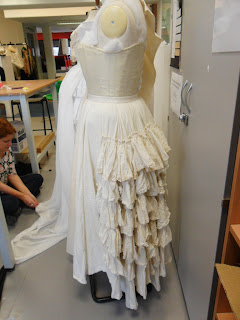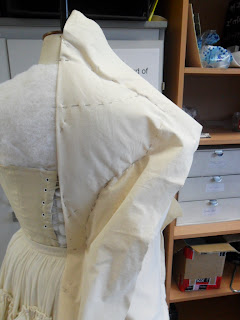To get the silhuette that is required for this deisgn i would need various layers of petticoats, unfortonalty there are not a large variaty of simluar full body petticoats to creat this look. To get the needed silhuette that i required I deicded to pad the one petticoat out around the waistline to give this fullyness required. The cartrage pleats of the skirt will also make the dress fuller.
To start draping this design i followed the insturctions first taught to me at the start of this univsity year. I started with the CF of the bodice and have decided to work from there.
I constantly refeared to both my deisgn and the pattern that acompanys the deisgn in the Arnold, J. (2009) book. I have used the pattern in the Arnold, J. (2009) books as a guide more than something to copy because the pattern is Arnold's interpritation of how the origional dress will have been cut by taking needed measurments of the origional dress. My body figure and the figure of women today is very different to that of women in 1830-40.
I have marked out potenal design lines with pins so that i can look at the bodice as a finished product before drawing all over the calico so that it is kept as neat as possible.
On the pattern that I have been refearing too it states that the side pannal has been cut on the bias, this is different to the way I have been taught at University. I decided that this might have been a technique used back in the 19th century and decided to keep with the way i have been taught and cut the side pannal on the straight of grain to match the center front and center back, because i could not think why the side pannal would need a extra stretch within the fabric when it is placed over the top of a very hard and fitted corset.
After playing with the calico I marked up all the seams, design lines and darts, took the calico off the mannique and made a pattern of this.
The patterns made from this cutting on the stand bodice can be seen in my workbook.













No comments:
Post a Comment